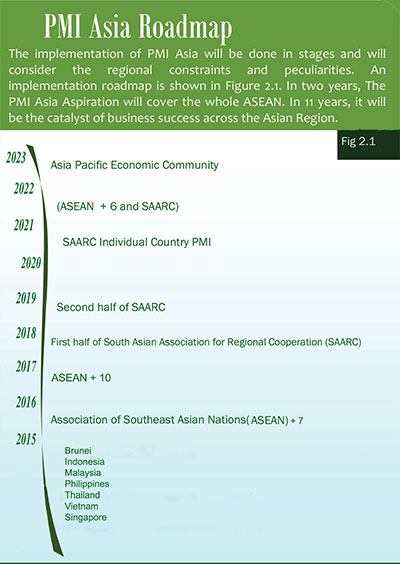
Economy Still in High Growth Mode Even as it Posts its Lowest April Index
Economy Sustains Expansion Despite Dropping to its Lowest March Index Ever
 The PMI ASIA Initiative
The PMI ASIA InitiativeGrowing Importance: In Asia, there is now a growing recognition of the importance of regional economic integration to generate growth impulses from within, especially in the wake of the East Asian crisis (CUTS International 2006).
A New Platform for Development: By coming together, Asia's economies have grown much stronger. The regional integration provides a new platform for economic development that is good for individual economies, good for Asia, and the rest of the world. The Asian Development Bank (ADB) considers this development as a "partnership for shared prosperity."
In Factory Asia: The 2010 ADB report on the Asian Economic Community suggests that the region's world-beating economic growth owes much to its success in developing an intricate web of regional supply chains and production networks, often known as 'Factory Asia' which offers exceptional cross-border collaboration involving shipments of raw materials and manufacturing parts and components crisscrossing the region, along with increasingly-business people, managers, and other skilled people, as well as foreign investment.
In Knowledge Management: The globalization of the supply chain brought with it new trends. This includes dual/multiple sourcing, geographical dispersion of suppliers, increased visibility up the supply chain, sophisticated analytics, and rapid response plans among others. With this mega shift, supply chain management, as a discipline, has become the source and repository of significant business and economic information.
Need for Regional Economic Indicator
Support to Regional Integration: To support the initiatives for regional cooperation and integration (RCI), ADB established the Office of Regional Economic Integration (OREI) in April 2005, to coordinate and support RCI initiatives by serving as a knowledge center and supporting ADB's programs in policy consultation and institutional capacity building for developing member countries as well as regional and sub-regional groups (ADB 2012).
A Composite Index: The Purchasing Managers' Index (PMI) is a composite index which measures factors such as new orders, production, supplier delivery times, backlogs, inventories, prices, employment, import orders, and exports. It measures the health of industries and is published monthly, based on information collected the prior month.
IFPSM Directive: During the world conference of the International Federation of Purchasing and Supply Management (IFPSM) that was held in Manila in April 2012, the IFPSM Board directed the Philippine Institute for Supply Management, Inc. (PISM) and Foundation of the Society of Fellows in Supply Management, Inc. and Foundation of the Society of Fellows in Supply Management, Inc. (SOFSM) was directed to conduct a study that will determine the feasibility of publishing PMI Asia. Countries represented during the board meeting supported the proposal and expressed interest in PMI Asia.
During the world conference of the International Federation of Purchasing and Supply Management (IFPSM) held in Manila in April 2012, the Philippine Institute for Supply Management, Inc. (PISM) and Foundation of the Society of Fellows in Supply Management, Inc. (SOFSM) was directed to conduct a study that will determine the feasibility of publishing PMI Asia."
Significance of PMI Asia: PMI Asia will further highlight the role of supply chain management and the profession in globalization and regional integration. It will substantiate the profession's key role in knowledge management and providing policy decision makers with timely and reliable information. More importantly, it will supplement existing reports and economic indicators and will help decision makers in policy formulation.
The PMI is used by fiscal and monetary planners in developed countries like United Kingdom, United States, France, Italy, Japan, Hong Kong, Germany and the Eurozone. It is an alternative measure of output and provides government policy-makers and decision-makers with a timely and regular economic barometer. PMI is conducted in 32 countries the results of which are widely used by policy-makers.
The PMI is a composite index which measures the monthly performance of the Economy. —whether the economy is expanding, contracting, remains the same. Central banks or monetary authorities use the PMI as a tool for planning.
 PMI Countries
PMI CountriesAt present, there are 32 countries with a PMI eight of which are in Asia. The eight Asian countries reporting a PMI are Hong Kong China, Singapore, Japan, China, India, Philippines, South Korea and Taiwan. There are other countries with plans to produce the PMI but these plans have not materialized. There are resources needed to implement the PMI.
PMI regional reports include PMI Eurozone and PMI North America. Within each region, there are PMI country reports. As of yet, there is no PMI Asia.
For more information about PMI Asia, please contact Ricardo Joaquin V. Sison, C.P.M., FSM (This email address is being protected from spambots. You need JavaScript enabled to view it.) of the Philippine Institute for Supply Management, Inc. or Romeo T. Recto, DSM (This email address is being protected from spambots. You need JavaScript enabled to view it.) Foundation the Society of Fellows in Supply Management, Inc.
Q1. How frequently do you use the internet (whether by phone or computer or other means) in a typical day)?
Respondents are classified according to hours of internet usage. This graph shows that most of the respondents are classified as Regular Users who spend 4-7 hours a day in using the internet.
Source: DigitalFilipino/I-MetricsAsia Events in 2016